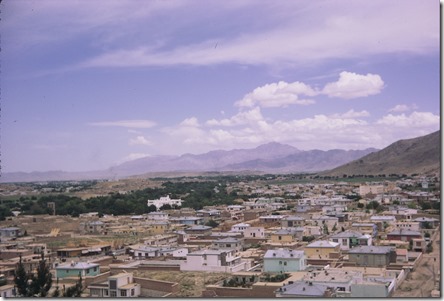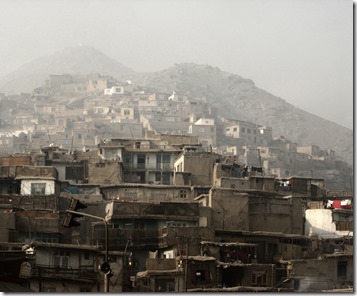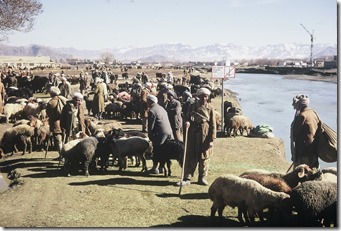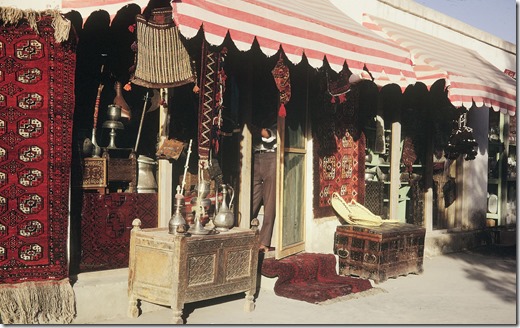I don’t know who took the first two pictures here but the story is that they were taken in 1968 by a British diplomat.
If anyone knows who I can contact to see whether I can display these with permission I would appreciate the contact info. And should the owner  of these pictures want them taken down I will do so instantly.
of these pictures want them taken down I will do so instantly.
They are truly something amazing, amazing that is for anyone who is familiar with the hell on earth of Afghanistan these days.
The picture to the left (click on any of them for a larger version) looks like it was taken from the cemetery hill near where the Intercontinental Hotel stands today.
It is indeed strange to see so many buildings intact and undamaged.
I don’t have any pictures taken in the same direction from 2004 but the one below shows how living space in Kabul has become so scarce that people have built up the steep slopes of the hills that ring the city.
Like much else in Afghanistan these houses are built of what amounts to mud brick. Although it rains here the houses are surprisingly sturdy and can easily last a generation or more before needing more attention. Nevertheless, they aren’t comfortable places in which to live and heating is a tremendous problem, along with the need to haul water up.
The one on right I took in 2005 or 06. It is the same stretch of hillside in downtown Kabul.  It’s a good illustration of how the city has been growing. There are not too may useable hillsides left for “condo” development. I knew several people who lived in these kinds of things and once when I mentioned how it is must be nice to have such a panoramic view one of them pointed out that everything runs downhill, including your uphill neighbor’s toilet waste.
It’s a good illustration of how the city has been growing. There are not too may useable hillsides left for “condo” development. I knew several people who lived in these kinds of things and once when I mentioned how it is must be nice to have such a panoramic view one of them pointed out that everything runs downhill, including your uphill neighbor’s toilet waste.
This next shot is interesting because it shows the Kabul River full of water. These days there is next to no water flow and for much of the year the river is nothing more than

The Kabul River in 1968 or so. Because of diversions and the destruction of Afghan forests it is nothing more than a muddy and sewage laden trickle. Photographer unknown
a series of unconnected stagnant and stinking pools of deep brown sludge. But of course, in a city where there is no reliable water or sewage system people use what they can. It is not unusual to see people drawing water from the pools for drinking while others are dumping waste and washing clothes.
The lack of water has been caused by changes in climate and by pretty heavy deforestation. Without trees to hold the water in the watershed it soon all runs away into Pakistan.
In the late sixties and through the 70’s Kabul was on the “Hippy Trail” a route that extended up out of India and Pakistan into the poppy growing areas of Afghanistan. The place was famous for a particularly nice Hashish. And one of the places you could buy it was Chicken Street in Kabul.
This furniture and carpet store pictured here in 1968 is still with us in the 21st century. I cannot be sure but I am pretty certain that I bought a carpet here myself in 2005, very much like the one hanging to the left of the picture. Perhaps it is the same one.
Anyway, if there is any hashish being sold on Chicken Street these days I would be greatly surprised. The country has a slack and corrupt police force but drugs are not tolerated. Justice would consist of tossing you into an overcrowded cell with no toilets or fresh water and leaving you there pretty much on your own for the next dozen years. People never come out of an Afghan prison the same way they went in.
Chicken Street, not its Afghan name by any means, got its name because it was once one of the great centres of cock-fighting in Central Asia. As the tales go, people would travel hundreds of miles at the beginning of the 20th century to try their hand betting on cock-fights.

Pots like these have probably been sold like this in Kandahar for hundreds of years. Rick Grant 2006
These days trade goes on much like it has for hundreds of years. Small shops selling whatever you want and if they don’t have it you can be sure that their “cousin” one street over will have it or their “uncle” can make it by tomorrow. It’s a good system, infinitely more enjoyable and useful than trekking through Wal-Mart or some plastic shopping mall in the middle of a bleak city. Just don’t expect a quick purchase, you always have to talk and chat and bargain, that is part of the system.












